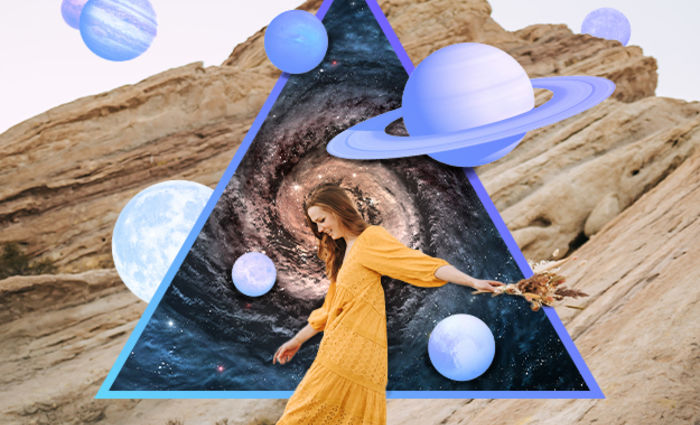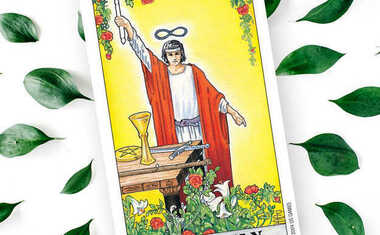
Astrological Glossary
Commonly used Astrology terms explained
Astrology is an incredibly complex field and goes well beyond the Sun sign information you may be used to reading about. This might be why, when running some of our personalized Astrology reports, you may have come across astrological terms you are unfamiliar with.
The guide below is meant to help you decode the mystery behind some of the most frequently used Astrology phrases out there, helping you get a better understanding of all the unique factors that go into making you, well, YOU!
Glossary Sections
Planet and Aspect Abbreviations Aspects Elements Houses PlanetsPlanet Abbreviations
Merc

Ven

Mars

Jup

Sat

Ura

Nep

Plu

Asc

MC

Aspect Abbreviations
Oppos

Trine

Squr

Conj

Sxtil

Qucnx

Aspects
An aspect in astrology describes the angular relationship between any two planets or other sensitive points (such as the Ascendant or Midheaven) in the 360 degree circle of the zodiac. The number of degrees between points is significant, and each major angle or aspect has a particular meaning. Astrologers always measure the shortest distance (or the smallest angle) between points, making 180 degrees the widest aspect possible.
Aspects cause the astrological influence of the two planets to "mix together" in specific ways that affect the person. In addition to the 180 degree opposition, there are many other distances that also are considered meaningful, such as 0 degrees (conjunction), 60 degrees (sextile), 90 degrees(square) and 120 degrees (trine). Each of these angles is called an aspect. Some astrologers use many other aspects as well.
The orb of an aspect is how far from exact it is. For example, a square aspect is 90 degrees. If 2 planets are separated by 91 degrees (or by 89 degrees) then the 2 planets are in square aspect with a 1 degree orb. In other words, they are 1 degree from being in exact square aspect. The larger the orb, the weaker the aspect. An aspect with a small orb is very powerful. Some astrologers consider much larger orbs than others. The allowable orb for a square aspect is believed by some astrologers to be as little as 2 or 3 degrees, and by some to be as large as 10 or 12 degrees. Although this difference of opinion may seem great, it does not have that great an effect on interpretation because virtually all astrologers agree that a narrower orb makes the aspect much more powerful. Therefore, narrow orbs factor much more strongly in chart interpretation.
Types of Aspects
Conjunction: 0 degrees
If two planets occupy the same degree or are very close to each other, they are said to be conjunct. Most astrologers believe that conjunctions are dynamic, but not as difficult and challenging as squares and oppositions. Planets that are conjunct tend to energize each other.
Opposition: 180 degrees
If two planets are close to being opposite to each other in the sky, they are forming an opposition aspect. Most astrologers agree that oppositions are challenging and often emphasize challenges with other people. However, the challenges suggested by an opposition can be balanced and resolved with effort.
Squares: 90 degrees
If two planets are close to being 90 degrees apart, they are said to be square to each other. Almost all astrologers agree that squares are motivating and challenging and can be difficult. Some astrologers emphasize the negative potential of a square, while others focus on the character-building potential inherent in this aspect.
Trine: 120 degrees
If two planets are close being 120 degrees apart, they are said to be trine to each other. Most astrologers agree that trines are soft and easy, pleasant, and harmonious, but sometimes lazy. But trines can provide relief from the tension inherent in more challenging aspects that also may be present in the person's chart.
Sextile: 60 degrees
If two planets are close to be being 60 degrees apart, they are said to be sextile to each other. Sextiles are similar to trine aspects and considered favorable.
Semi-Square aspect: 45 degrees
If two planets are close to being 45 degrees apart, they are in semi-square aspect. This minor aspect is similar to a square aspect, though often not quite as intense. Some astrologers feel that the semi-square creates very internal challenges or conflicts.
Sesquiquadrate: 135 degrees
If two planets are close to being 135 degrees apart, they are in sesquiquadrate aspect. Generally regarded as being similar to a square, but some astrologers feel that this minor aspect is easier to release and express than a square aspect.
Semi-Sextile aspect: 30 degrees
If two planets are close to being 30 degrees apart they form a semi-sextile aspect. Generally regarded as being a slightly harmonious or favorable minor aspect.
Quincunx: 150 degrees
If two planets are close to being 150 degrees apart, they form a quincunx aspect. Most astrologers view the quincunx, a minor aspect, as being awkward, difficult, and requiring adjustments from a person.
Elements
The four elements (Fire, Earth, Air and Water) describe the inherent temperament and orientation of each sign of the zodiac. As the ancient Greeks taught, everything in the universe including the human personality can be examined in terms of these elements. Fire is your basic enthusiastic urge, Earth represents practical, material world concerns, Air is the element of abstract thought, Water represents feelings and the empathetic impulse. Fire and earth are primary and focused on the self. Air and water are derivative and focused on others. Fire and air are naturally extroverted, optimistic, active and freedom-oriented. Earth and water are basically introverted, pessimistic, passive and security-oriented.
The Fire signs are Aries, Leo and Sagittarius. The Earth signs are Taurus, Virgo and Capricorn. The Air signs are Gemini, Libra and Aquarius. And the Water signs are Cancer, Scorpio and Pisces.
Houses and Their General Meanings
Your birth chart is divided into twelve "houses," which govern specific areas of your life. At the time of your birth, each planet was located in a particular astrological sign and in one of the twelve houses.
Listed below are the most general meanings for each house:
First House:
Your self-identity. How you appear to the world and the first impression you make on others. Your external presentation, including physical characteristics (body type, facial features, etc).
Second House:
Your personal resources. Money matters, possessions, and your relationship with both.
Third House:
Your immediate environment. Short trips, neighbors, communication with others, learning. Your relationships with siblings.
Fourth House:
Your home and family. Your childhood and ancestral roots. Your mother and maternal influences in general.
Fifth House:
Your creative inspiration and self-expression. Self-investment, risk-taking, love affairs, children, and luck.
Sixth House:
Your daily life. Health concerns, work, and service. Personal sacrifice.
Seventh House:
Your identity in relationship to others. Dating, marriage, partnerships of all kinds. Contracts.
Eighth House:
Sex and your relationship to the resources of others. Death and inheritance. Transformational release, and our ability to "rebound." Rituals of all types.
Ninth House:
Long-distance travel, higher education, philosophy, and mental expansion of all types. Law and publishing.
Tenth House:
Your relationship to authority and power. Reputation, social status, and career. Government institutions. Your father and authority figures in general.
Eleventh House:
Your friends and your connection to humanity in general. Group associations. Hopes and aspirations, ideals. Honors received.
Twelfth House:
Your spiritual life and your connection to the cosmos. Dreams and the unconscious. Things that are hidden. Music. Your karmic quest.
Planets
The Sun: Your Ego Structure
The Sun is the center of the solar system. All life revolves around it. In the same way, the ego is the center of personal identity and gives integration and continuity to individual experience. In this sense, it might be said that the Sun in astrology reveals a person's character and is the prime indicator of what the individual is trying to achieve. This is the fixed pillar at the center of the person around which all else circulates or revolves.
The sign placement of the Sun indicates how your natural drive and ambition are going to be directed. The sign of the Sun is the most primary indicator of the forms of experience you are attracted to. Further, this most important placement shows how and why you are attracted to these experiences.
The house placement of the Sun sign shows the primary area of expression for the individual in life. There is a psychological, emotional, and physical significance to the house placement of the Sun. Aspects to the Sun show ways that the core of the personality is linked to other component elements in the individual's life. Aspects to the Sun have a deep and overriding significance in the life of the individual and are generally more important and more prominent than other aspects in the chart.
The Moon: Your Personal Life.
The Moon inscribes a circle around the earth. It moves more swiftly than other astronomical bodies and thus represents day-to-day and moment-to-moment movements, adjustments, and preoccupations. The Moon in astrology represents the inner, emotional life, and the unconscious, which is molded and shaped by our environment, by events, and by social and familial expectations. Further, the Moon indicates how we respond to life as a result of our past habits and experiences, our heritage, and our individual and collective instincts.
The sign placement of the Moon tells a lot about your private inner life, how the instinctive and imaginative component of your mind operates, how you express your feelings and your most general experiences of your family and mother.
The house placement of the Moon shows how and where you make day-to-day adjustments and indicates which realm of experience will play a dominant role in your emotional life. Further, it shows the things you are most drawn to in order to gain emotional equilibrium.
The aspects of the Moon show general characteristics of the personality that are emphasized. Planets in aspect to the Moon are symbolic of qualities in the personality that are used instinctively, habitually and with a high degree of versatility.
While the Sun reveals your intended purposes and lessons for this present life cycle, the Moon represents what you have already done and developed, hence, what is instinctive and natural to you, and what you tend to do over and over again. Your childhood is also reflected in the Moon's placement, as it is through those childhood circumstances that any unresolved past-life issues are re-stimulated. Your subconscious predisposition is indicated by the Moon's position. It is the psychic imprint of the past. The nodes of the Moon in an astrology chart describe behavior patterns from the past and indicate the direction you are evolving toward as you move forward in your life.
Mercury: Your Mental Life.
Mercury is the closest planet to the Sun. From the viewpoint of the earth it seems to dart back and forth across the face of the Sun. Mercury is the planet of your mental life. It shows how you receive, process, and disseminate information. It also relates to short trips, siblings, and other aspects of your immediate environment. The sign placement of Mercury shows your basic attitude and mental habits. The aspects of Mercury show your scope of vision and your methods for accomplishing tasks.
Venus: Your Love Nature
The planet Venus shows the way you express your love nature and what you aspire for in life as good or beautiful. It also influences your approach to partnerships and indicates what adjustments will be made in order to encourage a loving relationship. Venus loves harmony and is drawn to social activities of all kinds, as well as the arts (music, dance, literature, and drama, among others). The sign placement of Venus describes your style of sharing your love with others. The house placement of Venus shows the natural area of expression for your love energy. The aspects of Venus indicate how and under what circumstances you express the gentle and loving side of your nature.
Mars: Your Energy
Mars is the planet of desire and will. It shows how you aim at your goals and how you power yourself toward your goals. Mars represents your most fundamental passions. The sign placement of Mars shows the fundamental nature of your assertions. The house placement of Mars shows the area of your life where you tend to be most active. The aspects to Mars show how and to what extent your desires and assertions are involved with other aspects of living.
Jupiter: Your Values
Jupiter is the king of the planets. He is in charge of the order of creation. Jupiter shows your values, where you feel confident and in control, and where you feel you have something to teach others. Jupiter also rules religion, philosophy, long-distance travel, and higher education. The sign placement of Jupiter describes your values in life. The house placement of Jupiter shows the area of life where you feel luckiest and the area where you receive the most help from other people and from the cosmos. The aspect patterns to Jupiter show the direct network of good and administrative power in your life.
Saturn: Your Obligations
The planet Saturn shows where you feel restricted. You feel obligations and fears through Saturn, the taskmaster of the zodiac. Saturn rewards discipline, hard work and perseverance. The sign placement of Saturn shows the basic type of energy connected with your obligations. The house placement of Saturn shows an area of life that you feel restricted in and where you have to work hard to obtain the things that come to you. The aspects of Saturn show the most direct involvement of other areas of your life with your feelings of responsibility.
Uranus: Your Search for Freedom
The planet Uranus is beyond the orbit of Saturn and can't be seen without the aid of a telescope. It represents the sky in us, that which transcends the limits of finite life. Uranus represents originality and unconventionality. It can stimulate sudden or erratic change, like that expressed in revolution, or the invention of new ways of doing things. The sign placement of Uranus shows your broadest striving for freedom. The house placement of Uranus indicates your area of direct unique expression. The aspects to Uranus indicate the way you express your need for higher consciousness.
Neptune: Your Spiritual Aspirations and Ideals
The planet Neptune has an almost perfectly circular orbit. It represents the part of our nature that strives for perfection, that looks to some higher ideal. The planet Neptune rules the ocean and the part of us that is beyond the limits of the shores of personal existence, namely the unconscious. It also rules our dreams. The culture moves with the cycles of Neptune and it is the primary indicator of your connection to the culture that you live in. The sign of Neptune shows an ideal that you desire to manifest. The house placement of Neptune shows the area of your life that you want to express this ideal in. The aspect patterns of Neptune indicate the most direct connections yet most subtle networking of your personality into the world at large.
Pluto: Your Need for Fundamental Change
The planet Pluto represents the dark underground part of you. It shows your ability to transform the most fundamental properties in your own inner nature. The sign of Pluto is the way the obsessive, compulsive and committed part of your nature expresses itself. The house placement of Pluto shows the area of life where you make your most fundamental and most potent changes. The aspects to Pluto show the deepest most unconscious links in your personality structure.
Ascendant
The ascendant is based on the time, day, and place of birth, and is both the sign and degree of the first house. The ascendant represents your "external self" and your outside appearance to the world, as well as the world's general perception of you as a person. It is also widely believed to rule your physical characteristics.
Midheaven
English for Medium Coeli, the Midheaven is a point on the natal chart located on the cusp of the 10th house. To astrologers, the Midheaven governs career, public reputation, and interactions with authority.



